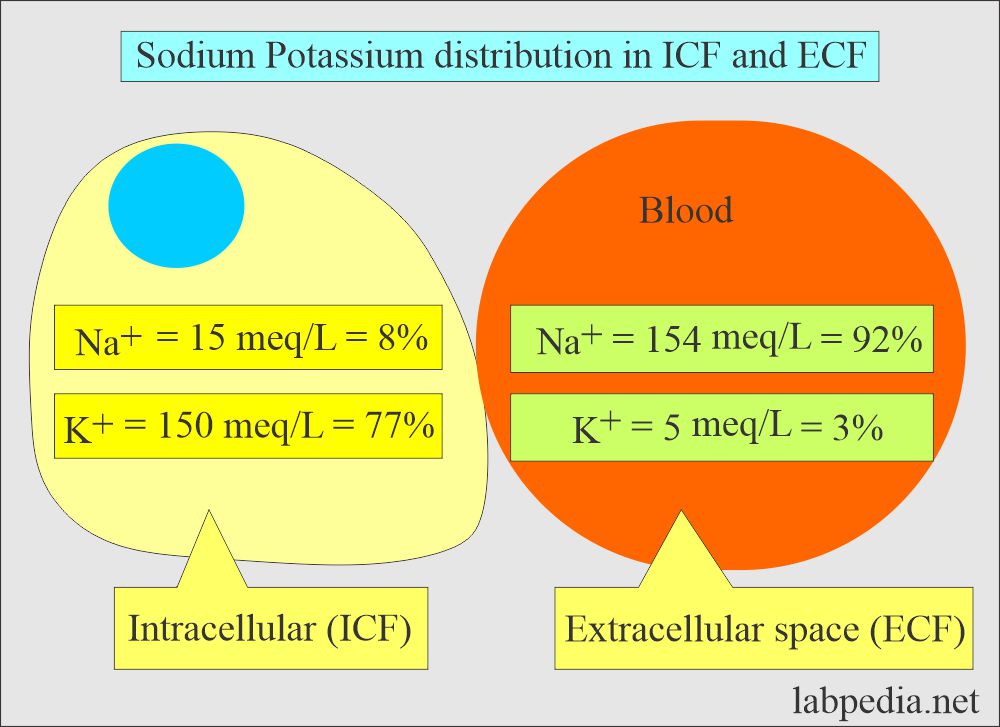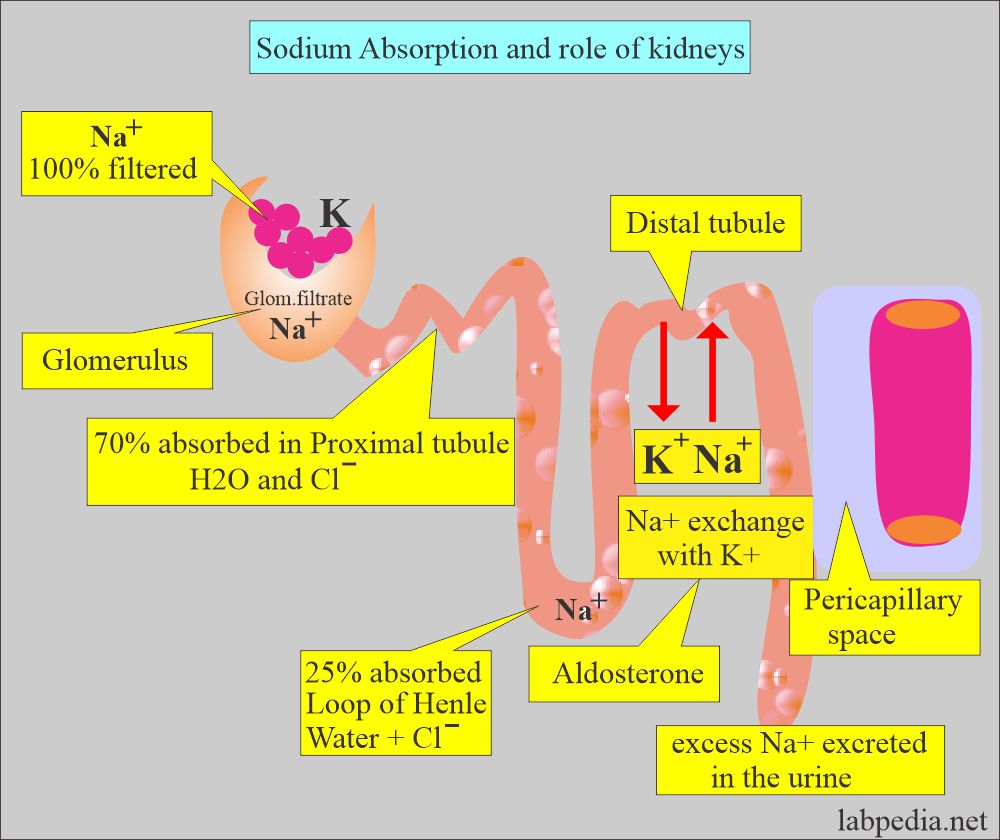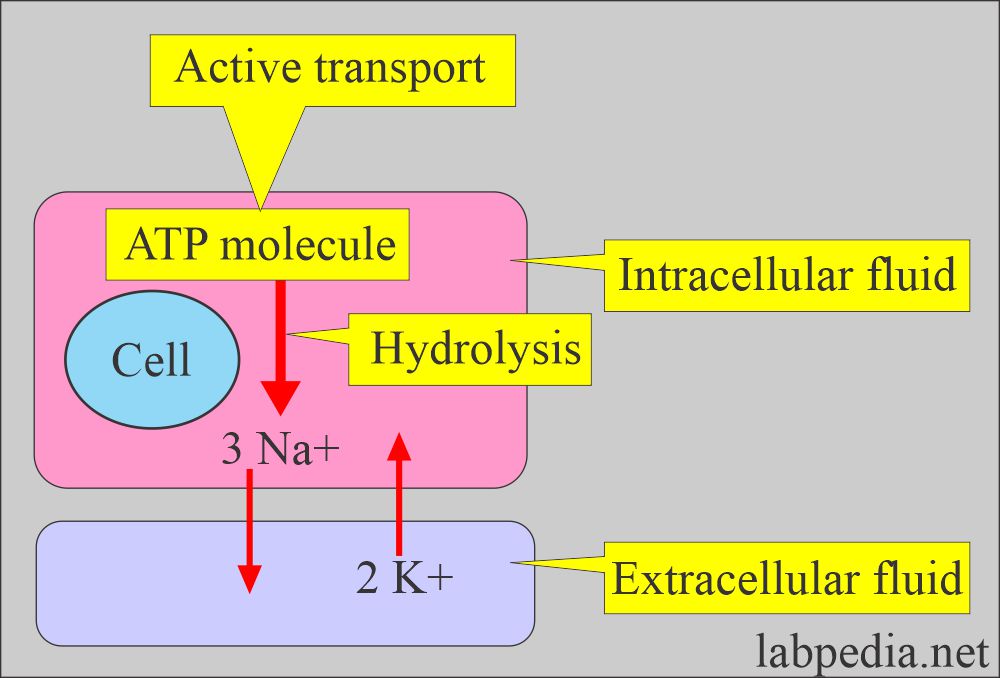Urine Sodium (Na+), Spot test, 24-Hour Urine Sodium
Urine Sodium (Na+)
What sample is needed for Urine Sodium?
- Can collect the random sample.
- Collect 24-hour urine samples.
- The urine container should be refrigerated or put on ice.
What are the precautions for Urine Sodium?
- Discard the first sample and collect all other samples for 24 hours.
- Add the last sample to the container.
- During collection, refrigerate the samples.
- Dietary intake of sodium salt increases the sodium level.
- Drugs that increase urine sodium are antidiuretics, antibiotics, steroids, laxatives, and cough medicines.
- Drugs that may decrease sodium levels are diuretics (furosemide, Lasix) and steroids.
- The increased level may be seen after caffeine, diuretics, dehydration, dopamine, postmenstrual diuresis, increased sodium intake, and vomiting.
- The decreased sodium level is associated with corticosteroids and propanolol in over-hydration and stress diuresis.
What are the indications for Urine Sodium?
- This test evaluates fluid and electrolyte abnormalities (acid-base balance).
- It is done to monitor the treatment.
- Advice for diagnosing adrenal diseases.
- Advice for the diagnosis of renal diseases.
What is the distribution of Sodium in the body?
- In a normal person, the total sodium in the body is 55 mmol/kg of body weight.
- 30% is tightly bound in the bone and is non-exchangeable.
- Extracellular sodium is mainly exchangeable, and intracellular sodium is only 2% to 3%.

Urine Sodium (Na+): Sodium Potassium distribution in the ICF and ECF
How will you discuss the pathophysiology of Urine Sodium (Na+)?
- Under normal conditions, the average adult takes 50 to 200 mmol/day of sodium.
- What are the routes for Sodium excretion?
- GI tract: Loss through the GI tract is very small. Fecal excretion of sodium is 1 to 2 mmol/day through feces.
- Skin: The average sodium content of the sweat is 50 mmol/L and is variable.
- Sweat is available; it is more in hot weather, exercise, and fever.
- Urine: The main route of excretion is through the kidneys.
- Urinary sodium maintains homeostasis and is critical to control the extracellular fluid.
- Sodium is filtered from the glomerulus, and then 70% is reabsorbed by the proximal tubule and 15% from the loop of Henle.
- 5% by the distal convoluted tubule, 5% by the collecting ductile in the cortex, and 5% by the collecting ducts in the medullary portion.
- <1% of the sodium excreted in the urine.
What are the Sodium (Na+) functions?
- Sodium is the primary regulator for retaining or excreting water and regulating the acid-base balance.
- Sodium is a major cation of the extracellular fluid.
- Sodium has the ability to maintain the acid-base balance by combining it with chloride and bicarbonate.
- It helps in neuromuscular function.
- Sodium is responsible for almost 50% of the osmotic strength of the plasma.
- It helps to maintain the osmotic pressure of the extracellular fluid.
- The daily diet contains 8 to 15 grams (130 to 260 mmol) per day.
- Body requirement is only 1 to 2 mmol, and the kidney excretes excess in the urine.
What is the effect of Aldosterone on sodium (Na+)?
- Aldosterone stimulates kidneys, decreases renal losses, and increases reabsorption.
- ADH control reabsorption of water at distal tubules affects Na+ level by diluting urine.
- Na+ promotes normal electrolyte balance in Intracellular and extracellular fluids in association with K+ under the influence of the Aldosterone hormone.
- This hormone promotes the 1:1 exchange of sodium for potassium or hydrogen ions.
- A natriuretic hormone produced in response to increased Na+ decreases reabsorption and increases Na+ losses.
Is Sodium transport an active process?
- The amount of sodium (Na+) in the body reflects the intake and output balance.
- The difference in the sodium concentration between intracellular water (ICW) and extracellular fluid (ECF) is the result of the active transport process, where sodium is released from the cell in exchange for potassium.
- Three molecules of Sodium are exchanged for 2 molecules of potassium.
- In hyponatremia, when the blood Na+ level is low due to inadequate intake, urine Na+ will also be low.
- In renal dysfunction, like chronic renal failure, urine Na+ is high, and serum Na+ is low.
What are the factors for maintaining normal urine Na+?
- Dietary intake.
- .The kidney’s ability to excrete the Na+.
- Effect of the aldosterone produced by the adrenal glands.
- It causes increased reabsorption of the Na+ in distal tubules and leads to a lower level of urine Na+.
- The posterior pituitary gland secretes the antidiuretic hormone.
- ADH controls the reabsorption of the water in the collecting ducts, causing its return to the bloodstream.
- It causes decreased water in the urine and an increase in the urine Na+.
- There is diurnal variation in the excretion of Na+; this is more in the daytime than during the night.
The basis of the test for urine sodium:
- This test evaluates the Na+ balance in the body by determining 24 hours of urinary Na+.
- Measurement of Na+ in urine gives information like:
- Acute renal failure.
- Adrenal disturbances.
- Acid-base balance.
- Evaluate patients with volume depletion.
- In acute renal failure:
- Raised Na+ level indicates Acute tubular necrosis.
- Low Na+ level indicate prerenal azotemia.
What is the normal urine sodium?
Source 1
| Age | meq/day |
| 6 to 10 years | |
| Male | 41 to 115 |
| Female | 20 to 69 |
| 10 to 14 years | |
| Male | 63 to 177 |
| Female | 48 to 168 |
| Adult | 40 to 220 |
| 27 to 287 |
The conversion factor for SI unit = x 1.0 = mmol/day.
Source 2
- 24 hours urinary sodium
- Adult = 40 to 220 meq/day (40 to 220 mmol/24 hours).
- Child = 41 to 115 meq/24 hours (41 to 115 mmol/day).
- Random urinary sodium = > 20 meq/L.
- Values are diet-dependent.
Another source
- 15 to 250 meq/L/day (15 to 250 mmol/L/day).
- It depends on hydration and the intake of dietary NA+.
Urine spot test:
- Typically <20 meq/L in dehydration.
- Normal or increased sodium intake = >40 meq/L.
What are the causes of increased urine Sodium?
- Diuretic therapy.
- Dehydration.
- Adrenocortical deficiency.
- Diabetic Ketoacidosis.
- Chronic renal failure.
- Excessive use of Na+ in the diet.
- Hypothyroidism.
- Toxemia of pregnancy.
- Syndrome of inappropriate ADH secretion.
What are the causes of decreased urinary sodium?
- Congestive heart failure.
- Diarrhea.
- Cushing’s syndrome.
- Malabsorption.
- Aldosteronism (Hyperaldosteronism).
- Inadequate sodium intake.
- Renal diseases like kidney failure or chronic renal diseases.
- A liver disease like cirrhosis.
- Diaphoresis.
- Pulmonary emphysema.
- Inadequate intake of sodium.
What is the presentation of urine sodium in clinical conditions?
| Clinical condition | Urine sodium (Na+) |
|
|
|
|
|
|
|
|
|
|
|
|
|
|
|
|
|
|
|
|
|
|
|
|
|
|
Questions and answers:
Question 1: What is the value of sodium in the cell?
Question 2: What is the main function of sodium in the body?



